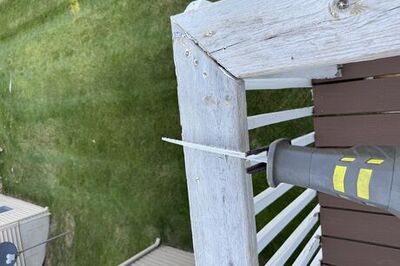
views
A large Hindu temple existed before the construction of Gyanvapi Mosque in Varanasi, said Advocate Vishnu Shankar Jain, representing the Hindu side in the case while reading out the report from the Archaeological Survey of India’s (ASI) survey.
Jain further claimed that the ASI report suggests that the temple was destroyed to construct the mosque.
“All the objects which were discovered were documented. No damages were caused to the structure. Based on scientific study, there is use of pillars of previous structure in the existing structure. The pre-existing structure was there,” Jain told reporters.
#WATCH | Varanasi, Uttar Pradesh | Advocate Vishnu Shankar Jain, representing the Hindu side, gives details on the Gyanvapi case.He says, “The ASI has said that there existed a large Hindu Temple prior to the construction of the existing structure. This is the conclusive… pic.twitter.com/rwAV0Vi4wj
— ANI (@ANI) January 25, 2024
Jain said pillars were studied systematically, and parts of the pre-existing Temple were reused in the construction of the new structure.
“The central structure of the pre-existing structure is being used as the hall of the existing mosque. The temple had a big central chamber, one centre to north, south and west. But remains to east and others couldn’t be ascertained,” he added.
#BreakingNews | Hindu side gets the copy of ASI survey of #GyanvapiMosque, “Pillars were studied systematically, parts of pre existing Temple were reused”, says Hindu side lawyer Vishnu Jain@anany_b shares more details#BrassTacks | @Zakka_Jacob pic.twitter.com/WjZjmvZ7iI— News18 (@CNNnews18) January 25, 2024
What is the Gyanvapi Mosque Case? History and Timeline of the Legal Battle Explained
‘Temple Destroyed To Built Mosque’
Jain further said that the carvings were destroyed to be reused. “34 inscriptions of the previous structure were used in the existing mosque. This means that the temple was destroyed to make this mosque,” he added.
Certain excerpts of the conclusion of the ASI report accessed by CNN News18 say, “Central chamber of the pre-existing structure forms the central hall of the existing structure. This structure with thick and strong walls, along with all architectural components and floral decorations was utilised as the main hall of the mosque. Animal figures carved at the lower ends of decorated arches of the pre-existing structure were mutilated, and the inner part of the dome is decorated with geometric designs.”
Based on the court’s order, the Archaeological Survey of India’s (ASI) report on Gyanvapi Mosque was provided to both Hindu and Muslim sides.
“This temple had a big central chamber and at least one chamber to the north, south east and west respectively. Remains of three chambers to the north, 8. south and west still exist but the remains of the chamber to the east and any further extension of it could not be ascertained physically, as the area is covered under a platform with stone flooring,” the report filed by the ASI said.
The report further stated that for the enlargement of the mosque and constructing sahan, parts of the pre-existing temple including pillars and pilasters were reused with little modifications.
“Minute study of the pillars and pilasters in corridor suggest that they were originally part of the pre-existing Hindu temple. For their reuse in the existing structure, vyala figures carved on either side of lotus medallion were mutilated and after removing the stone mass from the corners that space was decorated with floral design,” Page 134 of the ASI report read.
The ASI survey further revealed that a total of 34 inscriptions were recorded during the present survey and 32 estampages were taken. These are, in fact, inscriptions on the stones of the pre-existing Hindu temples, which have been re-used during the construction/ repair of the existing structure.
“They include inscriptions in Devanagari, Grantha, Telugu and Kannada scripts. Reuse of earlier inscriptions in e structure, suggest that the earlier structures were destroyed and their parts were reused in construction/repair of the existing structure,” the report read.
The Archaeological Survey of India (ASI) began working on a scientific survey of the Gyanvapi premises in August last year to determine whether the 17th-century mosque was constructed over a pre-existing structure of a Hindu temple.
The team members, along with the representatives of the Hindu petitioners to a legal dispute involving the mosque, were present inside the complex amid tight security. Members of the Anjuman Intezamia Masjid committee had boycotted the survey.
The survey began after the Allahabad High Court had upheld a Varanasi district court order and ruled that the proposed step is “necessary in the interest of justice” and will benefit both sides. The Apex Court too didn’t stall the survey after the assurance given by the Solicitor General saying that no structure would be damaged during the survey.

















Comments
0 comment